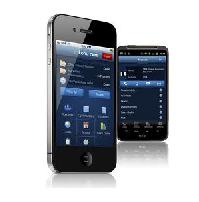As 2011 draws to an end, the playing field 
for mobile applications continues to adjust to consumer
demand, technology availability, and global recession.
Mobile carriers no longer have the home team
advantage. The expanding smartphone industry
coupled with multi- service companies entering the
market have made it’s anybody’s guess who will win the game.
1. Mobile Payment
Whether paying monthly bills, sending flowers, or buying furniture, mobile payments are the
easiest, fastest, and most convenient method to use. Since merchants, utilities, healthcare
organizations – anyone sending or receiving money – absorb less risk, mobile payment
services is attractive to consumers and businesses. The bank through which the payment is
made or the money transfer company handling the transfer of funds has the responsibility
for the securing the transaction and dealing with any problems. To date mobile payment
choices are still splintered with no defined operational practices plus regulatory requirements
are in flux, putting consumers of these services in the role of researchers looking for best
answers.
2. Mobile Browsing
More than half of all mobile phones have mobile browsing features. Easier to design and
manufacture, the mobile browsing apps are less costly to manufacture, which decreases
the turn-around-time on orders. They are also easier to update. This makes them a more
cost effective choice for companies making bulk purchases. Business to consumer (B2C)
applications continue to increase in popularity driving the market.
3. Money Transfer
Signing up millions of users quickly, new mobile money transfer companies have come under
close scrutiny by potential consumers and regulatory agencies. Like long-established money
transfer services, they have strong appeal. But unlike conventional services, the mobile transfer
companies utilize Short Message Service (SMS) which offers speed, online simplicity, and lower
rates. This has broad appeal to markets in both developing and technologically savvy countries.
Managing the regulatory requirements across widely diverse markets has created a new set
of challenges. The variables of service providers and advertising needs within each market in
addition to resource availability are just a few of the difficulties. As with any business handling
money, these new money transfer companies are also under close study by the multiplying
regulatory agencies. Regulators examine them in depth for information collection security
systems, explore the potential for money laundering, evaluate customer charges, and inspect
for fraud.
4. Mobile Health Monitoring
Rural areas far removed from healthcare facilities and remote populations in developing
countries stand to benefit from mobile health monitoring technology. Still in its infancy,
mobile health monitoring apps are being tested around the globe, and the results for
managing patients with chronic conditions such as diabetes, look promising. The potential
cost benefits to health insurers, government backed insurance plans, and patients are
driving the development of mobile health monitoring functions.
5. Near Field Communication Services
Near field communication (NFC) services permit simple data exchanges via a wireless connection
between two devices when placed within four (4) inches of each other. Some smartphones already
have the NFC chip and usage in the US is expected to climb. Asia and Europe are also on the playing
field. With NFC technology, credit card information and personal information can be stored thus
eliminating the risk of stolen credit cards or driver licenses –an attractive incentive. If customers
choose providers who offer these apps over more traditional providers, the NFC services market
growth will continue.
6. Mobile Music
Mobile music has been slow to establish a following unless you count ring tones. Clearly consumers
want music apps and are willing to pay given the success of iTunes. But, creative ideas for mobile
music and the offer of bundled services haven’t been enough to increase their market value thus far.
No front runner is seen for 2012.
7. Mobile Instant Messaging
Mobile Instant Messaging (IM) is real-time, text-based communication often between users on a
pre-determined contact or BFF list. With many people using mobile technology as their primary
communication format, the demand for IM continues to increase. Initially the cost of adding IM
apps to mobile phones discouraged customers. However, consumer requests continue to push
providers to make improvements to service availability and reduce charges. IM is an attractive
potential marketing outlet for mobile advertising and instantly access to social networks. In fast
paced environments, the immediacy of sending and receiving requests and acknowledgments,
the addition of webcams and free conversations over the Internet with headphones are attractive
and desired services.
8. Location-Based Services (LBS)
Location-based services have high consumer appeal with services that vary from tracking someone
down to requesting the location of the nearest pizza parlor. LBS may bring into play at a quicker rate
the controversial context-aware technologies, which still need substantial development. With the
wide array of features from social networks to tracking goals, some research firms are predicting
LBS users to more than double in the near future.
9. Mobile Search
People on the go want increased capability for online searches via their mobile phones. It saves
time, improves productivity, and opens new avenues for revenue. Mobile search technology is
lagging compared to market requests, but 2012 should see upgrades. These might include mobile
phone search engine ventures that share information.
10. Mobile Advertising
Global recession has increased mobile advertising in almost every market. Once again the ready
availability of Wi-Fi connections and smartphones is creating a new growth industry. It is
predicted that mobile advertisers will coordinate their ads across all media, including billboards.
Researchers predict mobile advertising to more than double in 2012. Consumers stand to benefit
if (and we know they will) carriers charge advertisers for air time. This could reduce the cost of
mobile phones and new apps.
